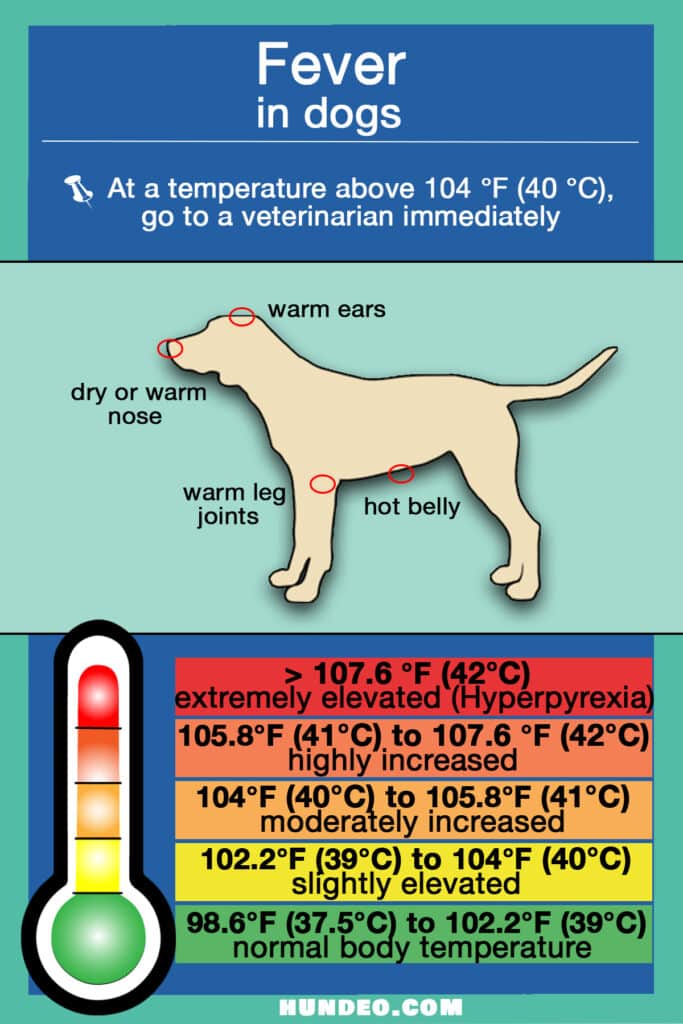Fever in the dog? (What is important in an emergency!)
- Veterinarian Mag.med.vet. Emin Jasarevic
- Updated: 2023-04-12
Your dog has a fever? Then you should act quickly and correctly. In this post, we'll show you how fever develops, how to recognize it, and 5 helpful tips on what to do now. In addition, for this article we have Advice from veterinarian Mag.med.vet. Emin Jasarevic obtained. Note: This article is written for the german country.

Fever is an accompanying symptom of many diseases, which should not be underestimated. A body temperature of over 40° C can lead to organ damage and is life-threatening for your dog.
How does fever develop?
Fever is a complex of symptoms in which there is not only an increase in internal body temperature, but also irregularly distributed skin temperature, bristling of the hair, chills, acceleration of the pulse and respiration, disturbed general behavior, decreased intestinal activity and thus decreased appetite and dry feces (fever feces).
Basically, increased body temperature is just a defense mechanism of the immune system.
When your pet has elevated body temperature, the immune system is usually trying to defend itself against pathogens and fight them.
However, if the body temperature rises above 40 °C, it can become life-threatening. The high temperatures put a strain on the organs and the circulation. Therefore, prolonged fever can lead to organ failure or circulatory collapse.
At temperatures above 40 °C, the body's own proteins are destroyed. This can have fatal consequences and even lead to the death of the animal.
So if you have a fever, you need to act fast! Take fever-reducing measures and take your four-legged friend to the vet immediately!
But please note: Not every increase in internal body temperature equals fever. In some cases, heat accumulation may occur due to, for example, increased external temperature or intense play/activity.
How to recognize a fever in a dog
The most important symptom is of course the increased body temperature. You can sometimes detect a fever in your furry companion even without a thermometer. Simple body contact is sufficient in some cases to detect, for example, heated ears, armpits or a hot belly.
Your protégé has probably lost fluids and is drinking more because of it. He is weakened, seems weak, plays less and seems to have no more energy.
Fever is often accompanied by loss of appetite and refusal of food.
A dry or warm nose can also be a sign of increased body temperature in a dog.
If the fever is severe, you may also experience chills, dehydration and febrile feces. Since your furry nose has lost fluid and the processing in the intestines is limited, the excretion is very dry and solid.
Here you will find a summary of the most important symptoms and accompanying symptoms of fever:
- hot ears
- Dry nose
- Fluid loss
- heavy panting
- Increased pulse
- eats less, refuses to eat
- Chills
- Feverfew

Important: Measure body temperature and vital signs
If some of the above symptoms apply to your pet, you can once again make absolutely sure that it really is a fever. Simply measure the body temperature with a standard clinical thermometer.
Electric thermometers are best suited for this purpose, as they signal the completion of the measurement with a beep.
In any case, you should have a separate thermometer for your protégé and preferably also label it. Then there can be no confusion.
Unfortunately, fever measurement via the ear does not work for quadrupeds. You have too many hairs in the ear canal, which can distort the result. Only a few degrees can make the difference whether the fever is life-threatening or not. That is why this method is much too inaccurate.
A reliable method is the measurement in the anus. Although this may be a little uncomfortable for your hairy companion at first, it is the only way to get an accurate measurement.
For the measurement, your little one should lie on his side and be relaxed. If necessary, you have to put him on a leash or even a muzzle for your protection.
Proper measurement is important
You can rub the thermometer with some Vaseline before measuring. Then lift the tail and insert the thermometer about 2 cm into its anus. When the measurement is done, carefully remove it again.
So that it goes faster in an emergency, the procedure should be practiced already in the puppy age. Then the fever measurement is routine at the end and facilitates you and your protégé a lot.
But even if it does not work immediately, you should stay calm and try several times. Maybe your pet will even get used to it.
At what point do dogs have a fever?
The normal temperature in the dog is between 37.5 °C and 39 °C. Normal temperature in puppies may be slightly higher and slightly lower in older dogs. Furthermore, smaller breeds tend to have higher body temperature and large breeds tend to have lower body temperature. In addition, the temperature depends on the effort and exercise. After romping, it can be over 39°C without hesitation.
From 39 °C one speaks of slightly elevated body temperature, from 40 °C of moderately elevated body temperature. If the condition lasts longer from 42 °C, it can be life-threatening for your dog. At a body temperature of 43 °C and above, the circulation and various organs can fail.
To prevent this from happening in the first place, you should take your pet to a veterinarian or animal hospital immediately if the temperature exceeds 40°C!
In addition to body temperature, you can also check other vital signs of your pet, including his pulse and breathing.
How do I measure pulse and breath?
To measure the pulse, use two fingers to find the leg artery on the inside of the thigh. Then count the pulse beats for 15 seconds and multiply the result by 4.
60 to 160 beats per minute are normal. In puppies, it can also be up to 220 beats per minute. If the pulse is higher, it may be a concomitant of fever.
When body temperature is high, your furry friend is probably breathing faster than usual. You can check his breathing by watching his chest rise or fall. If this is difficult to see, you can also hold your moistened hand in front of the muzzle. Panting does not count as breathing.160
5 tips to reduce fever
The first thing you should do is stay calm. A slight fever is no cause for concern and often goes away on its own. However, if the body temperature continues to rise, these tips will help you to reduce the fever naturally.
Rest break
Your protégé now needs a little time out from romping and playing. He has probably already lost fluids and is already tired. Do not encourage him to play dog sports and keep the walks as short as possible. Rest helps him the most at the moment.
Drink a lot
If he doesn't already do it on his own, you should encourage your pet to drink. This will help him to compensate for the loss of fluids. At the same time, it helps the body to lower the temperature again. Deliberately put drinking water within his reach. If he still does not drink anything, you can carefully give him water with a spoon. But do not force him to do anything!
Encourage eating
If your furry friend is eating less due to the fever, it's hurting circulation. Maybe you can regain his appetite with treats or his favorite food.
Cold compresses
With the help of cold compresses or damp towels you can try to cool the body from the outside. Just put them on the belly, paws or neck. It will do your fur bearer good and hopefully soon lower the fever.
Black cumin oil
This home remedy helps to strengthen the immune system. The faster the actual cause of the fever is combated, the shorter the increased body temperature lasts. Simply add a few drops of the oil to your pet's food or drinking water.
Homeopathy
At the beginning of a fever attack, homeopathic remedies can also be a good help. A single dose of Aconitum C30 globules or Belladonna C30 globules is often sufficient to reduce the dog's fever.
With an acute
The fever attack that occurs in the initial phase is also caused by the
Homeopathy serves well. A single dose of Aconitum C30 or
Belladonna C30 is often sufficient to reduce the fever of the dog.
lower.
Read more about the topic here: https://www.tiergesund.de/krankheiten/hund/fieberFrom a body temperature of 40 °C you should ask a veterinarian for advice. Remember that fever can rise quickly and only a few degrees Celsius can make a big difference.
Even if you are unsure of the reason for the fever, you should take your pet to the vet. You should do this especially if he is still a puppy, already older or sick.
Causes of fever
Fever usually occurs as a concomitant of another disease. The reasons can be very different. The spectrum of causes ranges from infectious diseases and poisoning to the concomitant of a vaccination.
Due to infectious diseases
- Lyme disease, anaplasmosis, TBE, babesiosis (all transmitted by ticks)
- Distemper
- Bronchitis
- Gastrointestinal infection
- Joint infection
- various Mediterranean diseases
due to inflammations
- Inflammation of the intestine
- Pancreatitis
- Liver inflammation (hepatitis)
- Pneumonia
- Otitis media
- Anal gland inflammation
- Meningitis
also through
- Poisoning
- External injuries such as bite wounds
- Penetrated foreign bodies
- Cancer / tumors / ulcers
- as a result of vaccination
- as a side effect of medication
What can the vet do?
First of all, the vet will try to reduce the fever of your pet. Either injections, suppositories or various medications are suitable for this. Antipyretic agents, such as carprofen.
It is also important to find out what is causing the unusually high body temperature. Since fever can be a concomitant of many different diseases, diagnosis is not always easy.
You should tell the vet everything that you have noticed about your pelt-nose's behavior in the last few days. This will help to narrow down the possible causes.
If the cause is known or at least suspected, it can be treated. For example, in the case of a bacterial infectious disease, your dog can be given antibiotics.
The body temperature returns to completely normal at the latest when the disease that caused the fever has been combated.
Frequently Asked Questions
In order to prevent serious consequential damage, you should take your pet to a veterinarian or veterinary clinic immediately if the temperature exceeds 40°C.
Fever is a defensive reaction of the body and immune system to infections and other diseases. The increased body temperature helps the immune system to fight pathogens.
Actually, an elevated temperature and slight fever are a sign of a well-functioning immune system. In most cases it is harmless and will go down again on its own. However, if the temperature rises above 40°C or higher, the body temperature must be lowered immediately and you should go to the vet.
You can reduce the fever by resting, drinking enough water or cold compresses. However, these are only temporary solutions. Take your dog to the vet to diagnose and treat the cause of the fever.
The best way to measure the fever is with a conventional clinical thermometer for humans. To get the most accurate value, it is recommended to measure the fever at the anus.
Veterinarian’s Recommendation
Even though fever is a normal defensive reaction of your dog's body, you should try to reduce it as quickly as possible from 40 °C. This is because too high a body temperature can put your pet in a life-threatening situation. Because too high a body temperature can put your pet in a life-threatening situation.
Despite everything, you must remain calm, no matter how many degrees Celsius the thermometer shows. After all, there's no point in getting carried away.
If you follow the tips for reducing fever step by step, your dog will surely feel better soon.
Remember, however, that these measures are not enough when the fever is high. You can use them to stabilize your dog. However, they are no substitute for a visit to the vet!

I am a veterinarian and writer on animal health topics. Animals are my passion, and it is my personal goal to create medically accurate articles and videos to educate pet owners as much as possible.
Share Now:

